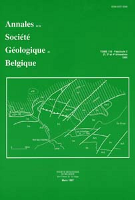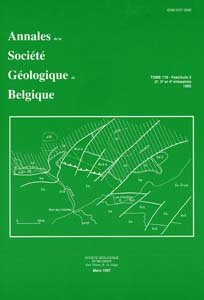- Startpagina tijdschrift
- Volume 101 (1978)
- Volume complet
- Aspects of the distribution of copper, zinc, nickel and chromium in the soils over amphibolites and granites in the Loko hills, Sierra Leone
Weergave(s): 325 (1 ULiège)
Download(s): 363 (22 ULiège)
Aspects of the distribution of copper, zinc, nickel and chromium in the soils over amphibolites and granites in the Loko hills, Sierra Leone

Résumé
Les roches des "Loko hills" font partie d'un groupe de roches archéennes constituant le "Kambui group" (Mc FARLANE et al., 1974). Les roches dominantes sont des amphibolites et des granites syncinématiques. Ces deux unités reposent apparemment en discordance sur des migmatites.
Un échantillonnage systématique et l'analyse des sols superficiels suivis du traitement statistique des résultats montrent que le Cu et le Zn ont une distribution très semblable de même que le Ni et le Cr.
L'analyse de régression montre que des quantités importantes de Cu, de Zn et de Ni peuvent être expliquées par la coprécipitation avec les sesquioxides pendant la pédogenèse. D'un autre côté, une grande partie de Cr est considérée comme localisée dans les minéraux primaires qui ont résisté à l'altération. Les faibles valeurs du Cu et de Zn échangeables mesurées peuvent être attribuées à la capacité d'échange de cations assez faible des sols. On a pu conclure que ce phénomène est principalement dû à la nature et à des modifications des particules colloïdales du sol découlant des changements dans l'environnement géochimique secondaire.
Abstract
The Loko hills schist belt is part of a wider group of Archaean rocks which form the Kambui group (McFARLANE et al., 1974). The dominant rocks are amphibolites and synkinematic granitoids. These two rock units rest apparently unconformably on a basement of acid migmatites.
Systematic sampling and analyses of near surface soils, and subsequent statistical treatment of the results indicate marked similarities in the distribution patterns between copper and zinc on the one hand, and between nickel and chromium on the other.
Regression analysis shows close associations between the members of the couples Cu-Zn and Ni-Cr. However, only nickel shows a strong positive correlation with the geology.
Partial extraction studies have shown that appreciable amounts of Cu, Zn and Ni can be accounted for in terms of coprecipitation with sesquioxides during pedogenesis. Chromium on the other hand is considered to be largely in primary minerals which have resisted weathering. The low values of exchangeable Cu and Zn have been attributed to an overall low base exchange capacity of the soils. It is concluded that this is principally due to the nature of and modifications to soil colloidal particles imposed by changes in the secondary geochemical environment.






